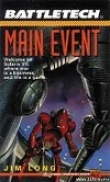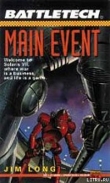
Текст книги "Main Event"
Автор книги: Джеймс Лонг
Жанры:
Боевая фантастика
,сообщить о нарушении
Текущая страница: 21 (всего у книги 21 страниц)
Glossary
POLITICAL TERMS
After the fall of the Star League General Aleksandr Kerensky, commander of the Regular Star League army, led his forces out of the Inner Sphere in what is known as the first Exodus. After making their way beyond the Periphery, more than 1,300 light years away from Terra, Kerensky and his followers settled in a group of marginally habitable star systems near a large globular cluster that hid them from the Inner Sphere. Within fifteen years, Civil War erupted among these exiles, threatening to destroy everything they had worked so hard to build. In a second Exodus, Nicholas Kerensky, son of Aleksandr, led his followers Jo one of the worlds of the globular cluster to escape the new war. It was there on Strana Mechty that Kerensky first conceived and organized the system that would one day become known as the Clans.
Though Wolfs Dragoons originated among the Clans, they have repudiated their allegiance to the Wolf Clan. Nevertheless many Clan traditions, concepts, and customs still prevail among the Dragoons.
CLANS
Out of the ashes of the civilization that Kerensky's forces tried to create rose the Clans. The Clans are a warrior society that is rigidly divided into castes, with the warriors as the elite. To create this warrior caste the Clans use genetic engineering, using the genes of prestigious living and dead warriors to produce potential new ones.
COMSTAR
ComStar, the interstellar communications network, was the brainchild of Jerome Blake, Minister of Communications during the latter years of the Star League. After the League's fall, Blake seized Terra and reorganized what was left of the League's communications network into a private organization that sold its services to the five Successor Houses for a profit. Since that time, ComStar has also developed into a powerful secret society steeped in mysticism and ritual. Initiates to the quasi-religious ComStar Order commit themselves to lifelong service. After the climactic battle between ComStar and the Clans on Tukayyid, ComStar splintered into two factions: the reformed ComStar and the arch-conservative Word of Blake.
INNER SPHERE
The Inner Sphere was the term originally applied to the star empires that joined together to form the Star League in the mid-2700s. The term currently applies to human-occupied space within the bounds of the Periphery.
PERIPHERY
Beyond the borders of the Inner Sphere lies the Periphery, the vast domain of known and unknown worlds stretching endlessly into interstellar night. Once populated by colonies from Terra, the worlds of the Periphery were devastated technologically, politically, and economically by the fall of the Star League. At present, the Periphery is the refuge of piratical Bandit Kings, privateers, and outcasts from the Inner Sphere.
STAR LEAGUE
The Star League was formed in 2571 in an attempt to peacefully ally the major star systems inhabited by the human race after it had taken to the stars. The League prospered for almost 200 years, until civil war broke out in 2751. The League was eventually destroyed when the ruling body, known as the High Council, disbanded in the midst of a struggle for power. Each of the royal House rulers then declared him or herself First Lord of the Star League, and within months, war had engulfed the Inner Sphere. This conflict continued for almost three centuries. This era of continuous war is now known simply as the Succession Wars.
SUCCESSOR LORDS
Each of the five Successor States is ruled by a family descended from one of the original Council Lords of the old Star League. All five royal House Lords claim the title of First Lord of the Star League, and they have been at each other's throats since the beginning of the Succession Wars in 2786. Their battleground is the vast Inner Sphere, which is composed of all the star systems once occupied by the Star League's member-states.
SUCCESSOR STATES
After the fall of the Star League, the remaining members of the High Council each asserted his or her right to become First Lord of the Star League. Their star empires became known as the Successor States and the rulers as the Successor Lords. Five ruling Houses make up the Successor States: House Kurita, House Liao, House Steiner, House Marik, and House Davion. The Clan invasion has temporarily interrupted the centuries of war—the Succession Wars—that first began in 2786. The battleground of these wars is the vast Inner Sphere, which is composed of all the star systems once occupied by the Star League's member-states. The Successor Lords have temporarily put aside their differences in order to meet the threat of a common foe, the Clans.
TRUCE OF TUKAYYID
The Truce of Tukayyid establishes a fifteen-year ceasefire between the Clans and the Inner Sphere. Khan Ulric Kerensky, ilKhan of the Clans, made a bargain with Com-Star's Precentor Martial, Anastasius Focht, to fight a battle on the planet Tukayyid. If the Clans won, ComStar would hand Terra over to them; if the Com Guards won, the Clans would agree to a fifteen-year truce. Signed by the Clans and ComStar after the Com Guards won an overwhelming victory against the Clans on Tukayyid, the truce establishes a boundary marking the front line of the Clan incursion into Inner Sphere space. The treaty forbids the Clans to advance beyond this boundary for a period of fifteen years.
MILITARY TERMS
The Inner Sphere and Clan militaries both use BattleMechs, DropShips, JumpShips and other similar weapons and equipment, but the Clans are superior from a technological standpoint. Clan warriors live by the Way of the Clans, a code of honor that affects even their style of combat. The Inner Sphere has never been able to defeat the Clans' superior technology. Their victories have onlycome through strategies that turned the tables on the code by which Clan warriors live and fight.
AUTOCANNON
An autocannon is a rapid-firing, auto-loading weapon that fires high-speed streams of high-explosive, armor-piercing shells. Light autocannon range from 30 to 90mm caliber, and heavy autocannon may be 80 to 120mm or more.
BATTLEMECH
BattleMechs are the most powerful war machines ever built. First developed by Terran scientists and engineers, these huge, man-shaped vehicles are faster, more mobile, better-armored, and more heavily armed than any twentieth-century tank. Ten to twelve meters tall and equipped with particle projection cannons, lasers, rapid-fire autocannon, and missiles, they pack enough firepower to flatten anything but another BattleMech. A small fusion reactor provides virtually unlimited power, and BattleMechs can be adapted to fight in environments ranging from sun-baked deserts to sub-zero arctic icefields.
BATTALION
A battalion is an Inner Sphere military unit usually consisting of three companies.
CLAN MILITARY
Clan military organization, strategy, and tactics differ radically from those of the Inner Sphere. The basic element of the Clan military is called a Point, consisting of a 'Mech, or two aerospace fighters, or five infantrymen. Five Points constitute a Star. Groups of Stars are called Clusters.
Point 1 'Mech or 5 infantry Elementals
Star 5 'Mechs or 25 Elementals
Binary 2 Stars
Trinary 3 Stars
Cluster 4 Binaries
Galaxy 3-5 Clusters
Nova 1 'Mech Star and 1 infantry Star
Supernova 1 'Mech Binary and 2 infantry Stars
COMPANY
A company is an Inner Sphere military unit consisting of three BattleMech lances or, for infantry, three platoons with a total of 50 to 100 men. Companies are generally commanded by a captain.
ELEMENTALS
Elementals are the elite, battle-armored infantry of the Clans. These men and women are giants, bred specifically to handle Clan-developed battle armor.
JUMPSHIPS AND DROPSHIPS
JumpShip
Interstellar travel is accomplished via JumpShips, first developed in the twenty-second century. These somewhat ungainly vessels consist of a long, thin drive core and a sail resembling an enormous parasol, which can extend up to a kilometer in width. The ship is named for its ability to "jump" instantaneously across vast distances—up to thirty light years per jump. Before it can make another jump, however, the ship must recharge its interstellar drives by gathering up more solar energy. This process can take up to a week.
The JumpShip's enormous sail is constructed from a special metal that absorbs vast quantities of electromagnetic energy from the nearest star. When it has soaked up enough energy, the sail transfers it to the drive core, which converts it into a space-twisting field. An instant later, the ship arrives at the next jump point, a distance of up to thirty light years. This field, generated by the Kearny-Fuchida hyperdrive, is known as hyperspace, and its discovery opened to mankind the gateway to the stars.
JumpShips never land on planets, and only rarely travel to the inner areas of a star system. Interplanetary travel is carried out by DropShips, vessels that are attached to the JumpShip until arrival at the jump point. Jump points are the locations within a star system where the system's gravity is next to nothing, the prime prerequisite for the operation of the Kearny-Fuchida drive. Every star has two principal jump points, one at the zenith point at the star's north pole, and one at the nadir point at the star's south pole.
DropShip
Because interstellar JumpShips must avoid entering the heart of a solar system, they must "dock" in space at a considerable distance from a system's inhabited worlds. DropShips were developed for interplanetary travel. As the name implies, a DropShip is attached to hardpoints on the JumpShip's drive core, later to be dropped from the parent vessel after insystem entry. Though incapable of FTL travel, DropShips are highly maneuverable, well-armed, and sufficiently aerodynamic to take off from and land on a planetary surface. The journey from the jump point to the inhabited worlds of a system usually requires a normal-space journey of several days or weeks, depending on the type of star.
LANCE
A lance is an Inner Sphere BattleMech combat group, usually consisting of four BattleMechs.
LASER
Laser is an acronym for "Light Amplification through Stimulated Emission of Radiation." When used as a weapon, the laser damages the target by concentrating extreme heat on a small area. BattleMech lasers are designated as small, medium, and large. Lasers are also available as shoulder-fired weapons operating from a portable backpack power unit. Certain range finders and targeting equipment also employ low-level lasers.
LRM
This is an abbreviation for long-range missile, an indirect-fire missile with a high-explosive warhead.
OMNIMECH
The Clans' military success against the Inner Sphere is mainly due to the OmniMech. Based on advanced Star League technology that the Star League Defense Forces took with them when they left the Inner Sphere, Clan scientists developed the OmniMech, a BattleMech whose modular weapons systems could be easily reconfigured to suit any mission. This innovation gave the Clans tremendous flexibility on the battlefield. Coupled with their vastly more efficient cooling and sensor systems and destructive firepower, the OmniMech made the Clans virtually invincible. Since encountering the OmniMech, Inner Sphere scientists have tried to incorporate Clan technology into Inner Sphere 'Mech designs.
PLATOON
A platoon is an Inner Sphere military unit typically consisting of approximately twenty-eight men, commanded by a lieutenant or a platoon sergeant. A platoon may be divided into two sections.
PPC
This abbreviation stands for particle projection cannon, a magnetic accelerator firing high-energy proton or ion bolts, causing damage through both impact and high temperature. PPCs are among the most effective weapons available to BattleMechs.
REGIMENT
A regiment is an Inner Sphere military unit consisting of two to four battalions, each consisting of three or four companies. A regiment is commanded by a colonel.
SRM
This abbreviation stands for short-range missiles, direct-trajectory missiles with high-explosive or armor-piercing explosive warheads. They have a range of less than 1 kilometer, and are accurate only at ranges of less than 300 meters. They are more powerful, however, than LRMs.








